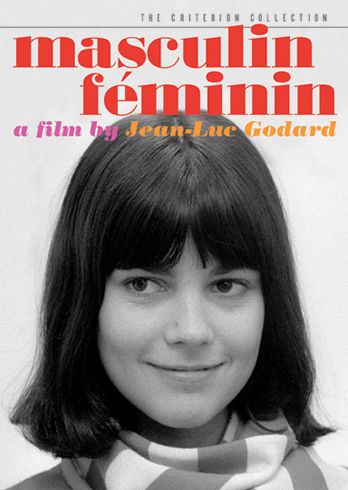|
Reviews of Recent Independent, Foreign, & Documentary Films in Theaters and DVD/Home Video
MASCULIN FÉMININ (1966)
One of my favorite moments from all the interviews included in this edition of Masculin
féminin is when film critic Dominique Païni discloses he smoked the same brand
of cigarettes and wore similar tweed jackets as this film’s protagonist, Paul (Jean-Pierre
Léaud), for months after he first saw the film. Ironically, Masculin féminin has become
as docilely iconoclastic as the Coke bottles for which Godard had such critical disdain. A film
centering on “the Children of Marx and Coca Cola” has ultimately produced children of Godard
and cassis, eager to emulate its characters’ counterculture habits and shell out $29.95 for DVDs of Godard’s seminal films. It’s pretty genius.
The film follows Paul, a young disaffected Marxist, and his tenuous relationship to a
detached ingénue, Madeleine (Chantal Goya), who is contentedly locked in a culture of
magazines and pop songs. As Adrian Martin describes in the DVD’s 16-page booklet, Masculin
féminin is much more a “film essay” about the Sartrean violence that goes ignored in our
everyday lives than a documentary, drama or an allegorical satire. Which is why the narrative
plot is largely unimportant (outside of its symbolism), and the characters are basically loudspeakers for Godard, voicing bitter and often hilarious criticism through their detached stereotypes.
DVD Extras: In the 1966 interview, it’s fascinating to see how similar Goya is to her
character - an unaware, compliant ingénue who makes yé-yé pop songs and says her
wish is to one day own a shop. What’s so enjoyable is to see that an hour and a half of symbolism
and irony involving Godard’s criticism of Goya and the rest of her Pepsi generation could have
been reduced to a five-minute interview with her. It’s a point that Goya returns to in her 2005
interview while explaining that her lines were mostly responses to questions Godard
asked her through an ear piece. On camera, she would answer as she normally would rather than
as a character. It’s a stimulating interview that helps to illuminate Godard’s techniques, with the
highlight of the entire DVD being Goya’s reminiscence of once saying angrily to Godard, “The
only art I know about is my Cuisinart!” The interview with cinematographer Willy Kurant is
also worthwhile. He knew he was a “one-off mistress” to Godard’s regular cinematographer,
Raoul Coutard (his “official wife”). He discusses the choices of lighting, Godard’s canonical
switch to Kodak film, and the aspect ratio choice - everything that a Godardphile would want to
know. The interview with sometime collaborator Jean-Pierre
Gorin and the discussion between critics Freddy Buache and Païni are less
informative since they largely conjecture on Godard’s legacy. But one of the most difficult
aspects to watching Godard today is understanding his films' historical framework. Both of these featurettes
help break that barrier by discussing the French New Wave and how Godard fit into that time
frame, what was new about the film, how it marked a point within Godard’s own evolution,
and, more importantly, how his films were received and why. Normally, DVD extras like the
booklet and the theatrical trailer wouldn’t be significant at all - but Adrian Martin’s essay and the
trailer are both so well done that they’re actually worthy of your time. Martin writes about
understanding 1965 through Godard as a teenager in the ‘80s, giving another interesting
backdrop for the first-time viewer. And watching the trailer - provocative and original in its own
right -is like viewing Godard’s visual commentary on his own film. Zachary Jones
|
